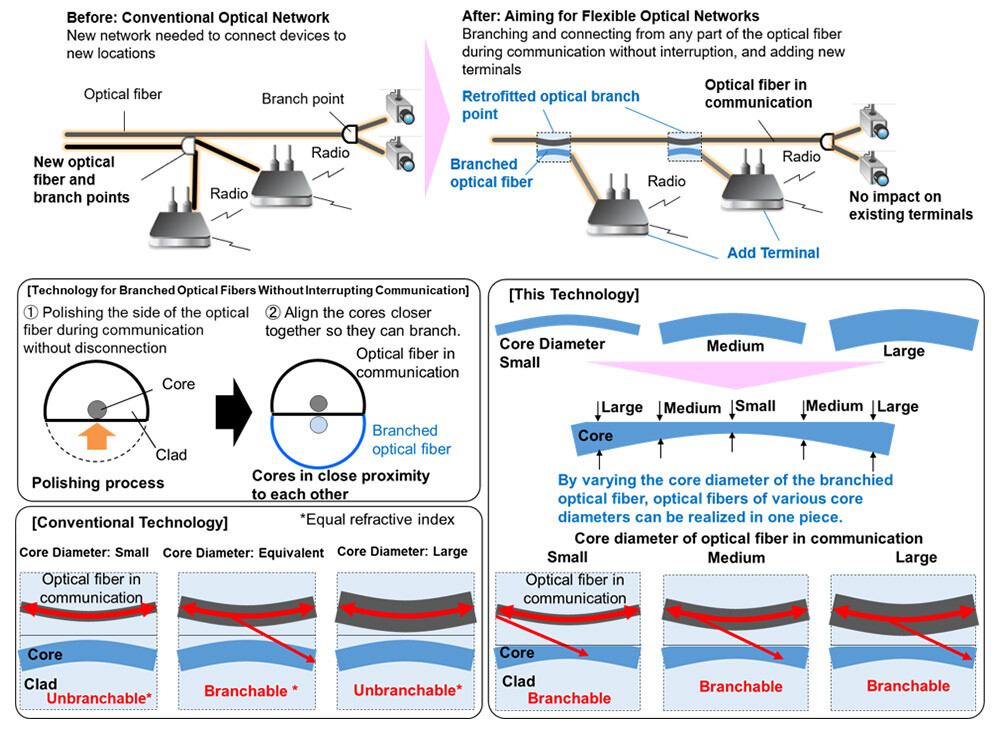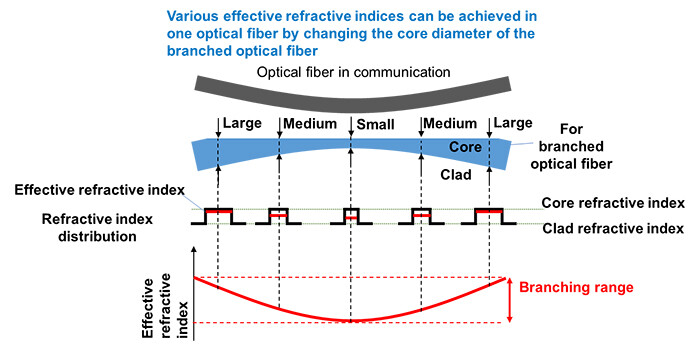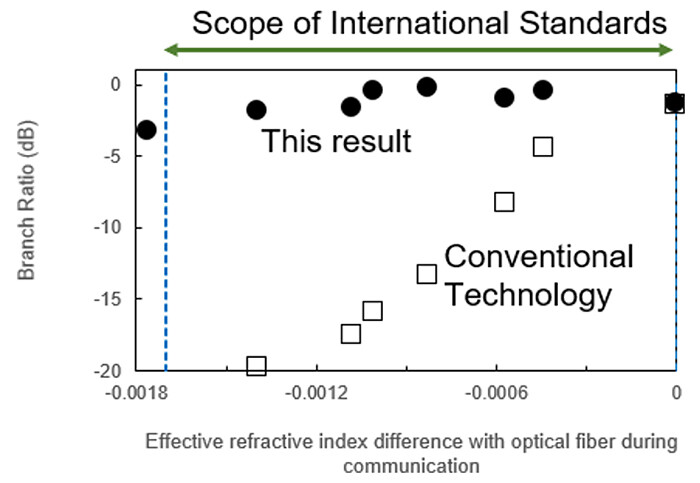Microsoft ends support for Internet Explorer on June 16, 2022.
We recommend using one of the browsers listed below.
- Microsoft Edge(Latest version)
- Mozilla Firefox(Latest version)
- Google Chrome(Latest version)
- Apple Safari(Latest version)
Please contact your browser provider for download and installation instructions.
April 24, 2024
NTT Corporation
World's first: Successful experiment to branch and merge various types of optical fibers without communication interruption
Toward the realization of flexible optical networks that connect from anywhere
News Highlights:
- For the first time in the world, we have demonstrated a construction technology that allows various types of optical fibers to branch and merge without communication interruption
- The development of a fabrication method for branched optical fibers with a structure of varying core diameters enables them to be used as optical fibers with various effective refractive indices
- This method is expected to reduce the cost of facility construction and shorten the construction period by preventing the expansion of new networks
Tokyo - April 24, 2024 - NTT Corporation (NTT) has demonstrated, for the first time in the world, a construction technology that allows various types of optical fibers to branch and merge without causing communication interruption.
This result is expected to reduce the cost of facility construction and shorten the construction period for telecommunications carriers. In the future, it is expected to improve convenience for users by flexibly responding to the increase in the number of IoT devices and other devices that are expected to expand rapidly.
These results will be presented at the Tsukuba Forum 20241 to be held from May 16 to 17, 2024.
 Figure 1 Flexible Optical Networks and Key Points of the Achievement
Figure 1 Flexible Optical Networks and Key Points of the Achievement
1. Background
With the advancement and spread of optical communication technology, various IT terminals is expanding in our daily lives. In line with this trend, various terminals such as radio base stations and sensors are expected to be connected to the network. This requires a flexible optical network that allows various of terminals to connect quickly and easily. However, since it has not been possible to change the network configuration without interrupting communication, to connect terminals to a new location, it has been necessary to construct a new optical fiber cable or other network, which has resulted in high equipment construction costs and time required to open the network.
2. Technological challenges
Optical fibers used worldwide have various refractive index distributions2 and have different propagation characteristics (effective refractive index3) (Figure 2).
Conventional technologies for branching these optical fibers require the same propagation characteristics (effective refractive index) for the optical fiber at the source and the optical fiber at the destination of the branch. Therefore, it was necessary to know the effective refractive index of the optical fiber at the branch source and to prepare an optical fiber for branch suitable for it. However, in order to grasp the effective refractive index, it is necessary to stop the service of the optical fiber at the branch source. Given this background, it has become a challenge to establish a technology that enables branching of optical fibers during communication regardless of their effective refractive index (Figure 2).
 Figure 2 Examples of Various Optical Fibers and Challenges of Conventional Technology
Figure 2 Examples of Various Optical Fibers and Challenges of Conventional Technology
3. Key points of this achievement
In this work, we have developed a fabrication method for branched optical fibers with a structure in which the core diameter is varied (Figure 3). Since the effective refractive index varies with the core diameter, the optical fiber of this structure can be used as an optical fiber with various effective refractive indices (Figure 4). By using this structure as a branched optical fiber, it is possible to branch optical fibers regardless of the effective refractive index of the source optical fiber. NTT has demonstrated for the first time in the world the technology for fabricating this branched optical fiber.This greatly expands the range of optical fibers that can be branched compared to conventional optical fibers, and has made it possible to branch and merge all optical fibers that meet the international standard4,5 commonly used in optical access networks.
 Figure 3 Structure of Branched Optical Fiber with Varying Core Diameter
Figure 3 Structure of Branched Optical Fiber with Varying Core Diameter
 Figure 4 Results of the Experiment
Figure 4 Results of the Experiment
4. Outlook
With this achievement, we have established technology to branch various optical fibers in communication without interruption. This technology is expected to enable the realization of flexible optical networks that can be connected from anywhere without affecting communications, and to enable telecommunications carriers to reduce facility construction costs and shorten construction periods, thereby making it possible to use the network earlier than before. To apply this technology in the field, we will continue to evaluate the environmental resistance characteristics and conduct field verification using prototype devices, aiming to realize a flexible optical network that can be connected from anywhere and respond quickly to diversifying customer needs.
1Tsukuba Forum 2024
https://www.tsukuba-forum.jp/e/
2Refractive index distribution
Diameter of the core of the optical fiber and refractive index of the core and cladding. The core is where the light travels, and the cladding is where the refractive index is slightly lower than the core to confine the light around the core within the core
3Effective refractive index
Parameters determined by the diameter of the core of the optical fiber and the refractive index difference between the core and the cladding
4ITU-T G.652
The international standard for single-mode fiber for general-purpose optical communications established by ITU-T (International Telecommunication Union Telecommunication Standardization Sector) and most widely used in the world
5ITU-T G.657.A1
The international standard for single-mode fiber for optical communications with characteristics equivalent to those of G. 652 but with low bending loss characteristics (allowable bending radius 10 mm)
About NTT
NTT contributes to a sustainable society through the power of innovation. We are a leading global technology company providing services to consumers and businesses as a mobile operator, infrastructure, networks, applications, and consulting provider. Our offerings include digital business consulting, managed application services, workplace and cloud solutions, data center and edge computing, all supported by our deep global industry expertise. We are over $97B in revenue and 330,000 employees, with $3.6B in annual R&D investments. Our operations span across 80+ countries and regions, allowing us to serve clients in over 190 of them. We serve over 75% of Fortune Global 100 companies, thousands of other enterprise and government clients and millions of consumers.
Media contact
NTT Information Network Laboratory Group
Public Relations
nttrd-pr@ml.ntt.com
Information is current as of the date of issue of the individual press release.
Please be advised that information may be outdated after that point.
NTT STORY
WEB media that thinks about the future with NTT









